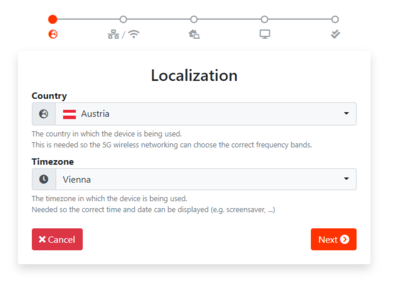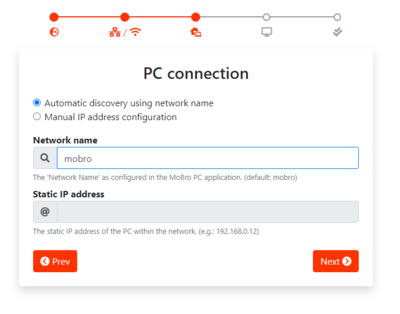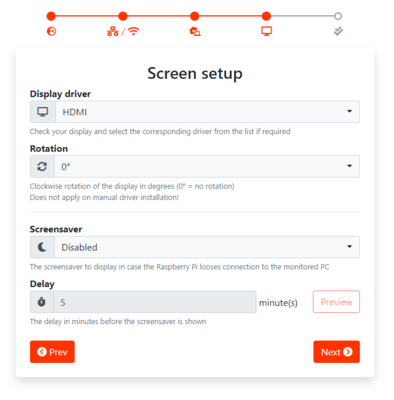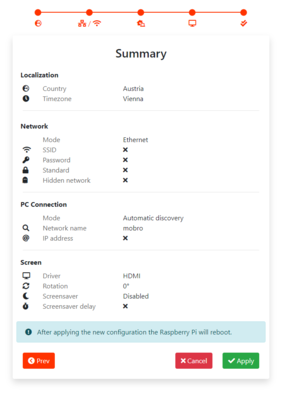This page will guide you through the setup and configuration of our custom Raspberry Pi image.
It's based on and targeted at the most recent image version.
Requirements:
- supported Raspberry Pi
- micro SD card flashed with the latest image
- HDMI or GPIO display
- power supply for the Raspberry Pi
- heatsink for the Raspberry Pi (recommended)
Preparation
- Install the heatsink on your Raspberry Pi (recommended, see Points to consider - Temperature)
- Insert the SD card into your Raspberry Pi
- Then continue by connection your display. Depending on your display of choice this can be either done via HDMI or GPIO
- Now connect your Pi to the power supply
Having done that, your Pi should start booting and you should see the Raspian boot sequence on your display.
Raspberry Pi 4: If you're using a HDMI display on a Raspberry Pi 4, make sure to connect the HDMI cable to the micro HDMI port that is closer to the USB-C power connector.
GPIO: If you're using a GPIO display you won't see anything just yet and your screen will most likely be completeley white or black. This is normal, as you haven't installed the required driver yet.
We will do that later on.
Configuration page
After starting the Pi we need to access the configuration page.
How you do this is dependent on how your Pi will be connected to your network.
Wireless
If no ethernet cable is connected the Raspberry Pi will automatically start in wireless mode.
Since we haven't configured anything yet, it wont be able to connect to the network just yet.
After booting the Pi will automatically open a configuration hotspot (MoBro_Configuration).
Use a wireless device like your phone or notebook to connect to that hotspot, no password is required. After connecting, open a browser and go to 192.168.4.1 by just typing it into the address bar.
The Raspberry will also show these instructions on its connected screen.
GPIO display: Once again, if you're using a GPIO display you won't see anything just yet, as the required driver is not yet installed.
Just give the Pi a minute or two to boot up and then check for the configuration hotspot that will be created.
Ethernet
In case you connected your Pi directly via an ethernet cable, it will automatically switch into ethernet mode and connect to the network.
Therefore no configuration hotspot will be created.
In order to access the configuration page you will need to check for the Pis IP address within your network. After you got that, just open a browser on any device connected to the same network and navigate to that IP address by typing it into the address bar.
Initial configuration
After booting up and successfully opening the configuration page, we will now configure the Raspberry Pi.
In most cases this has to be done just once.

If you open the configuration page this is the page that you will initially see.
It lists the currently active configuration.
By clicking on the 'Configuration Wizard' button at the bottom our interactive wizard will open and guide you through the configuration process.
Localization
First off we need to take care of localization.
You need to set the following:
Country: In case you're using a 5GHz wireless network you need to select the country your currently in so the networking can choose the correct frequency bands.
Timezone: This is required so the Raspberry Pi can display the correct date and time (e.g. for screensavers as explained further down)

Network
First off we need to configure the network.
If the current network mode is 'Ethernet' you can skip this page and just continue as the network is already set up and connected.
In case of wireless operation you need to set the following:
SSID: select the network you want to connect to. If your wireless network is not listed, you can also just manually input its SSID into the field
Password: the password for the selected network. Your password is only saved locally on the Rasbperry Pi and not shared with anyone.
If you need or want to specify the WPA version and encryption method you can do this under 'Advanced settings'.
If you're trying to connect to a hidden wireless network you will need to select this as well.
For normal operation you most likely don't need to touch these two settings.

PC connection
In order to display the stats of your PC the Rasbperry Pi needs to locate it on the network and connect to it.
This can be done by either of two ways:
Automatic discovery: This is the default method. The Raspberry will automatically scan your network and search for the PC running the MoBro desktop application.
Just make sure the network name is the same as configured on the PC application.
By using the network name the Raspberry is able to distinguish between multiple PCs running the MoBro software in the same network.
If you have only one PC running in your network you can just leave this at the default: mobro.
Static IP: If you know your PCs IP address you can configure the Pi to just check this one address.
This will avoid scanning the whole network and speed up the time taken to locate and connect to your PC.

Screen setup
Now we will configure the connected screen.
If your screen is connected by HDMI and is already working you're already good to go.
Display driver: If you're using a GPIO screen, this is finally the moment where we will install the required driver for it to function.
The MoBro Raspberry Pi image comes preloaded with drivers for some of the most popular displays.
Just select the driver that matches your display in the drop down.
In case the appropriate driver is not listed, just select 'Manual installation' and you can install it later on manually via SSH as described here.
Rotation: In case your screen is mounted vertically or the content is displayed upside down you can rotate the screen.
The rotation is specified in degrees clockwise, where 0° equals no rotation.
(Does NOT apply if you manually install a display driver)
Screensaver: You can enable and select a screensaver that will kick in if the Raspberry Pi looses connection to the monitored PC. This is especially useful in case you turn off your PC but leave the Raspberry Pi running at the same time.
Once the screensaver kicks in, the Raspberry keeps checking for the PC periodically in the background. If it finds the PC to be reachable again it will automatically connect and switch back to the monitoring screen.
Delay: A delay in minutes before the Raspberry Pi will switch to the screensaver after loosing connection to the monitored PC.

Summary / Confirmation
As a last step before applying our selected configuration is listed again.
Take the time to double check whether you selected everything correctly.
Once you click 'Apply' the new configuration will be written to the Raspberry and a reboot will be triggered.
If you're using a GPIO screen and selected the correct driver for installation you should finally see the Pi boot up again and open the MoBro on the screen.

Changing configuration later on
Like already mentioned the configuration process normally needs to be completed just once.
But in case you need to access configuration again afterwards to change something you can always do this.
If the Raspberry is connected to your network (ethernet or wifi) you can access the configuration page by just typing in the Raspberry Pis IP address into a browser.
In case the Raspberry is no longer able to connect to your wifi network it will automatically open a configuration hotspot again.